Comparative Analysis: Egypt and Mesopotamia Societies - History Essay
VerifiedAdded on 2021/11/16
|5
|845
|265
Essay
AI Summary
This essay provides a comparative analysis of Mesopotamian and Egyptian societies, focusing on their governance, social structures, and the roles of men and women. It begins by highlighting the geographical differences, with Egypt developing around the Nile and Mesopotamia between the Euphra...
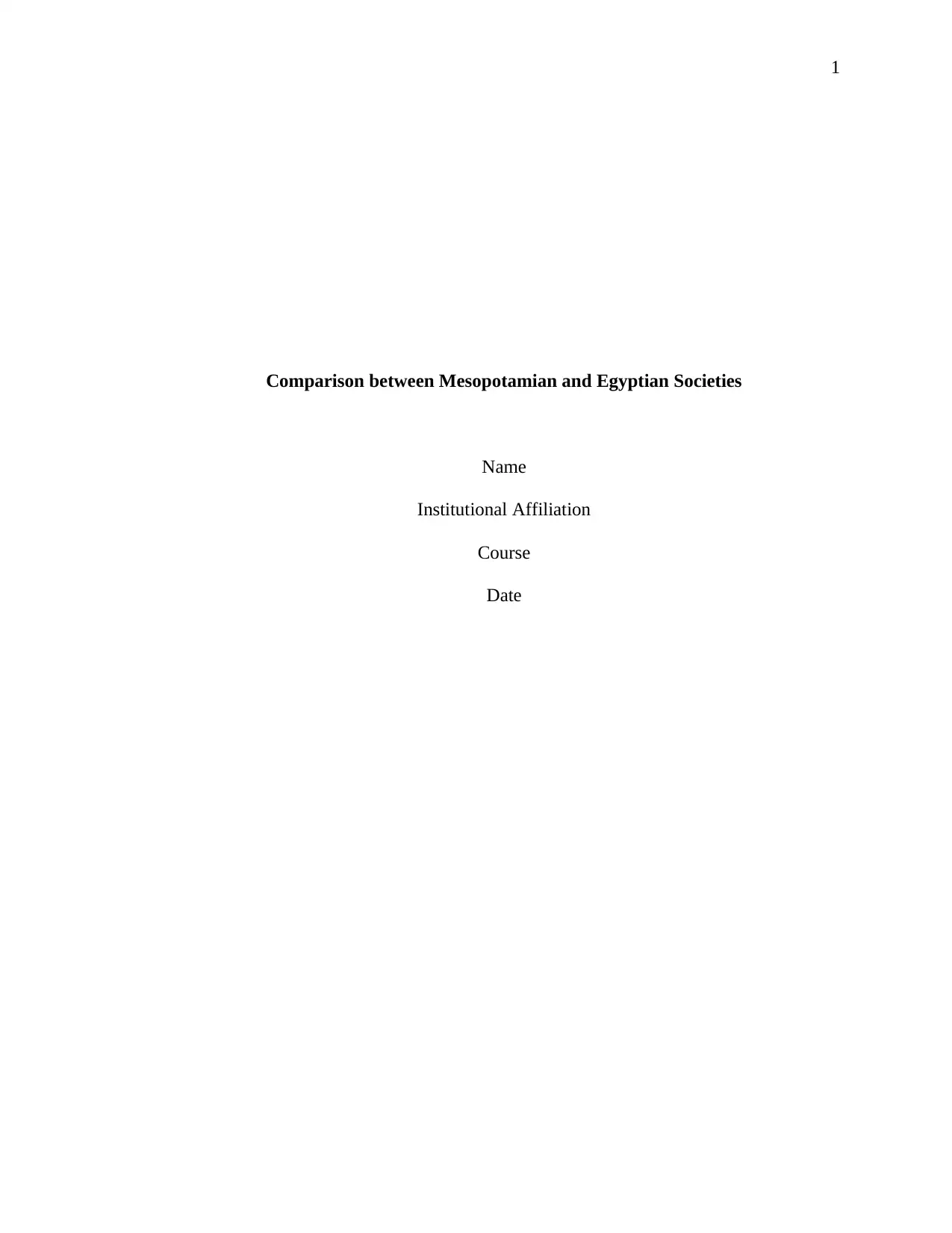
1
Comparison between Mesopotamian and Egyptian Societies
Name
Institutional Affiliation
Course
Date
Comparison between Mesopotamian and Egyptian Societies
Name
Institutional Affiliation
Course
Date
Paraphrase This Document
Need a fresh take? Get an instant paraphrase of this document with our AI Paraphraser
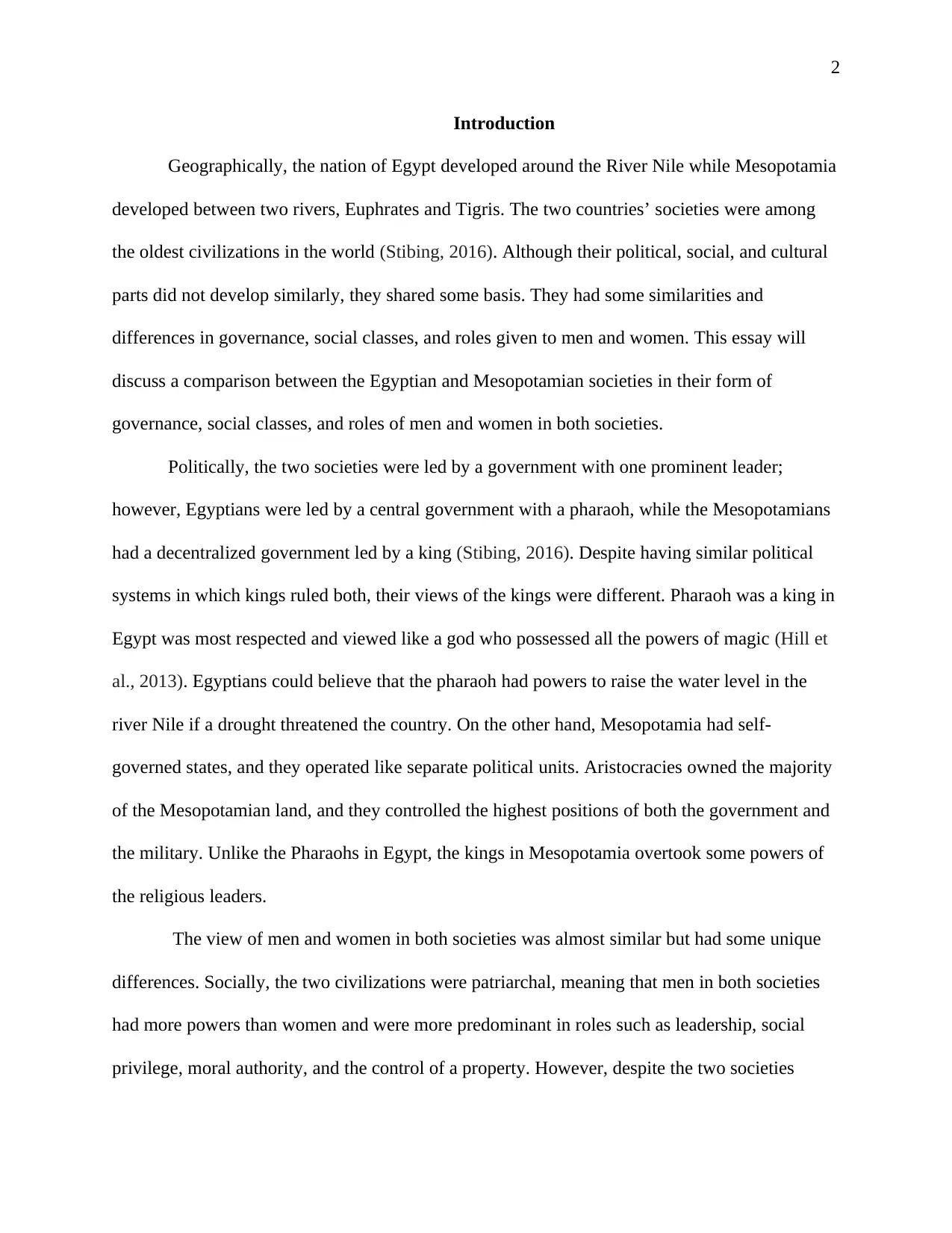
2
Introduction
Geographically, the nation of Egypt developed around the River Nile while Mesopotamia
developed between two rivers, Euphrates and Tigris. The two countries’ societies were among
the oldest civilizations in the world (Stibing, 2016). Although their political, social, and cultural
parts did not develop similarly, they shared some basis. They had some similarities and
differences in governance, social classes, and roles given to men and women. This essay will
discuss a comparison between the Egyptian and Mesopotamian societies in their form of
governance, social classes, and roles of men and women in both societies.
Politically, the two societies were led by a government with one prominent leader;
however, Egyptians were led by a central government with a pharaoh, while the Mesopotamians
had a decentralized government led by a king (Stibing, 2016). Despite having similar political
systems in which kings ruled both, their views of the kings were different. Pharaoh was a king in
Egypt was most respected and viewed like a god who possessed all the powers of magic (Hill et
al., 2013). Egyptians could believe that the pharaoh had powers to raise the water level in the
river Nile if a drought threatened the country. On the other hand, Mesopotamia had self-
governed states, and they operated like separate political units. Aristocracies owned the majority
of the Mesopotamian land, and they controlled the highest positions of both the government and
the military. Unlike the Pharaohs in Egypt, the kings in Mesopotamia overtook some powers of
the religious leaders.
The view of men and women in both societies was almost similar but had some unique
differences. Socially, the two civilizations were patriarchal, meaning that men in both societies
had more powers than women and were more predominant in roles such as leadership, social
privilege, moral authority, and the control of a property. However, despite the two societies
Introduction
Geographically, the nation of Egypt developed around the River Nile while Mesopotamia
developed between two rivers, Euphrates and Tigris. The two countries’ societies were among
the oldest civilizations in the world (Stibing, 2016). Although their political, social, and cultural
parts did not develop similarly, they shared some basis. They had some similarities and
differences in governance, social classes, and roles given to men and women. This essay will
discuss a comparison between the Egyptian and Mesopotamian societies in their form of
governance, social classes, and roles of men and women in both societies.
Politically, the two societies were led by a government with one prominent leader;
however, Egyptians were led by a central government with a pharaoh, while the Mesopotamians
had a decentralized government led by a king (Stibing, 2016). Despite having similar political
systems in which kings ruled both, their views of the kings were different. Pharaoh was a king in
Egypt was most respected and viewed like a god who possessed all the powers of magic (Hill et
al., 2013). Egyptians could believe that the pharaoh had powers to raise the water level in the
river Nile if a drought threatened the country. On the other hand, Mesopotamia had self-
governed states, and they operated like separate political units. Aristocracies owned the majority
of the Mesopotamian land, and they controlled the highest positions of both the government and
the military. Unlike the Pharaohs in Egypt, the kings in Mesopotamia overtook some powers of
the religious leaders.
The view of men and women in both societies was almost similar but had some unique
differences. Socially, the two civilizations were patriarchal, meaning that men in both societies
had more powers than women and were more predominant in roles such as leadership, social
privilege, moral authority, and the control of a property. However, despite the two societies
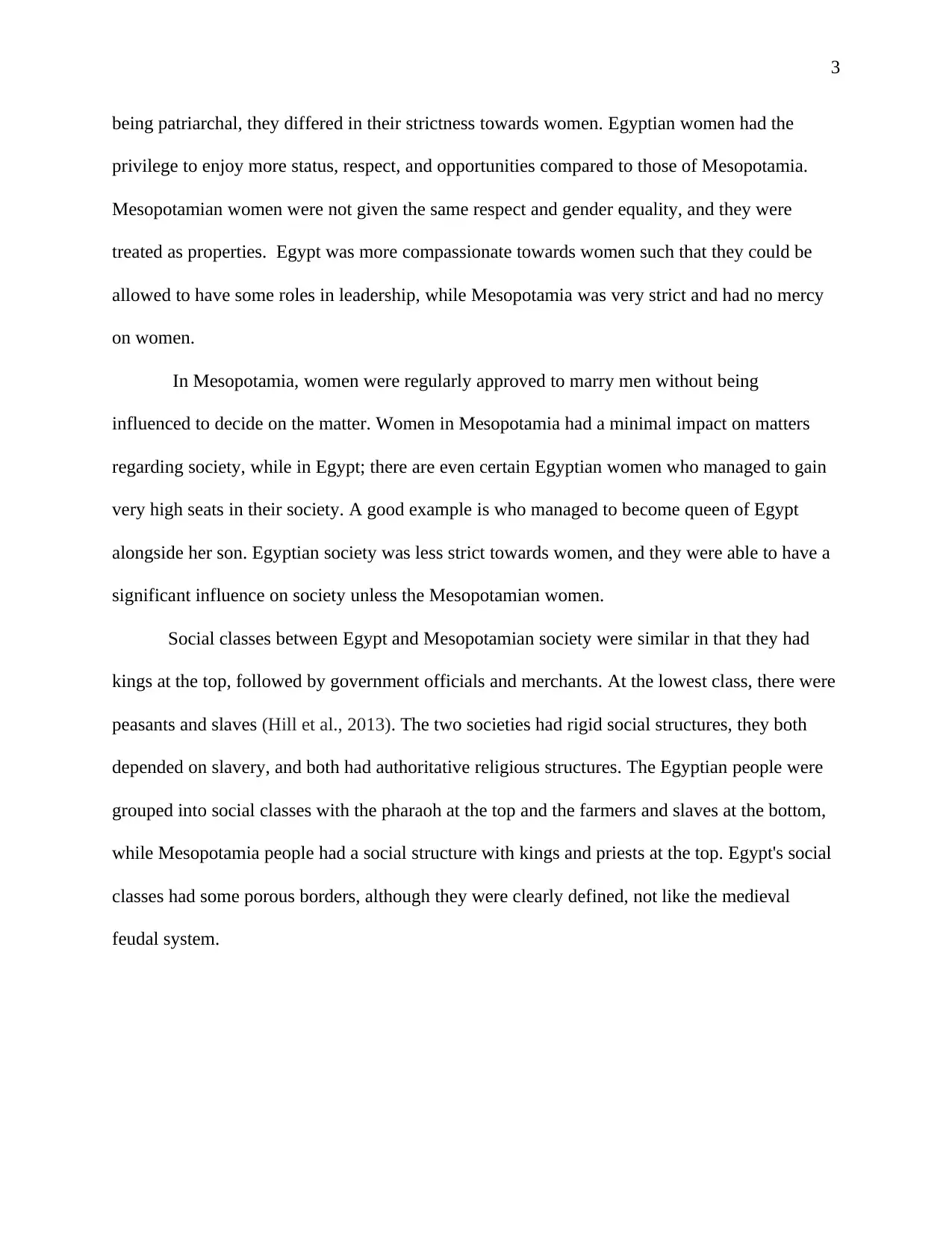
3
being patriarchal, they differed in their strictness towards women. Egyptian women had the
privilege to enjoy more status, respect, and opportunities compared to those of Mesopotamia.
Mesopotamian women were not given the same respect and gender equality, and they were
treated as properties. Egypt was more compassionate towards women such that they could be
allowed to have some roles in leadership, while Mesopotamia was very strict and had no mercy
on women.
In Mesopotamia, women were regularly approved to marry men without being
influenced to decide on the matter. Women in Mesopotamia had a minimal impact on matters
regarding society, while in Egypt; there are even certain Egyptian women who managed to gain
very high seats in their society. A good example is who managed to become queen of Egypt
alongside her son. Egyptian society was less strict towards women, and they were able to have a
significant influence on society unless the Mesopotamian women.
Social classes between Egypt and Mesopotamian society were similar in that they had
kings at the top, followed by government officials and merchants. At the lowest class, there were
peasants and slaves (Hill et al., 2013). The two societies had rigid social structures, they both
depended on slavery, and both had authoritative religious structures. The Egyptian people were
grouped into social classes with the pharaoh at the top and the farmers and slaves at the bottom,
while Mesopotamia people had a social structure with kings and priests at the top. Egypt's social
classes had some porous borders, although they were clearly defined, not like the medieval
feudal system.
being patriarchal, they differed in their strictness towards women. Egyptian women had the
privilege to enjoy more status, respect, and opportunities compared to those of Mesopotamia.
Mesopotamian women were not given the same respect and gender equality, and they were
treated as properties. Egypt was more compassionate towards women such that they could be
allowed to have some roles in leadership, while Mesopotamia was very strict and had no mercy
on women.
In Mesopotamia, women were regularly approved to marry men without being
influenced to decide on the matter. Women in Mesopotamia had a minimal impact on matters
regarding society, while in Egypt; there are even certain Egyptian women who managed to gain
very high seats in their society. A good example is who managed to become queen of Egypt
alongside her son. Egyptian society was less strict towards women, and they were able to have a
significant influence on society unless the Mesopotamian women.
Social classes between Egypt and Mesopotamian society were similar in that they had
kings at the top, followed by government officials and merchants. At the lowest class, there were
peasants and slaves (Hill et al., 2013). The two societies had rigid social structures, they both
depended on slavery, and both had authoritative religious structures. The Egyptian people were
grouped into social classes with the pharaoh at the top and the farmers and slaves at the bottom,
while Mesopotamia people had a social structure with kings and priests at the top. Egypt's social
classes had some porous borders, although they were clearly defined, not like the medieval
feudal system.
You're viewing a preview
Unlock full access by subscribing today!
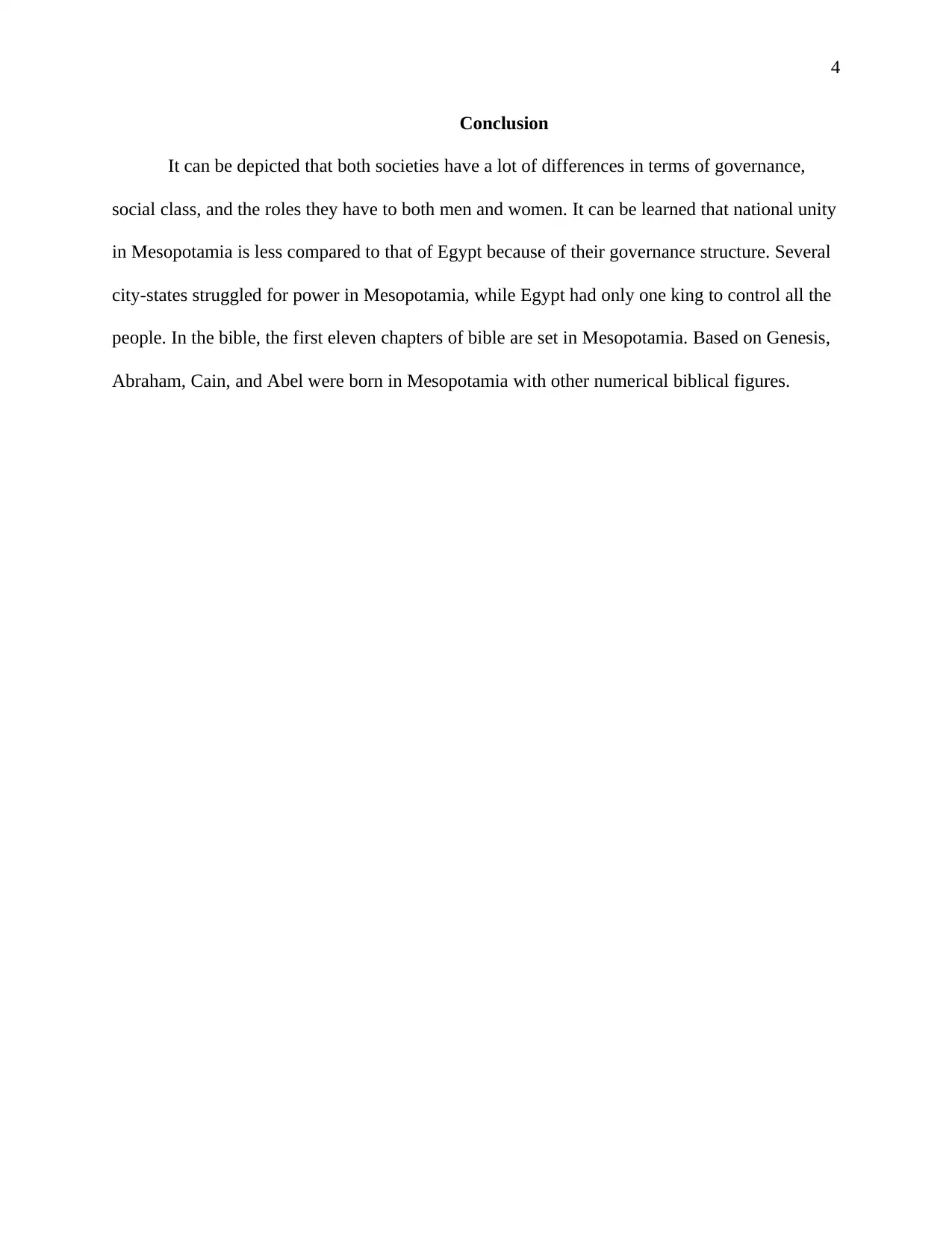
4
Conclusion
It can be depicted that both societies have a lot of differences in terms of governance,
social class, and the roles they have to both men and women. It can be learned that national unity
in Mesopotamia is less compared to that of Egypt because of their governance structure. Several
city-states struggled for power in Mesopotamia, while Egypt had only one king to control all the
people. In the bible, the first eleven chapters of bible are set in Mesopotamia. Based on Genesis,
Abraham, Cain, and Abel were born in Mesopotamia with other numerical biblical figures.
Conclusion
It can be depicted that both societies have a lot of differences in terms of governance,
social class, and the roles they have to both men and women. It can be learned that national unity
in Mesopotamia is less compared to that of Egypt because of their governance structure. Several
city-states struggled for power in Mesopotamia, while Egypt had only one king to control all the
people. In the bible, the first eleven chapters of bible are set in Mesopotamia. Based on Genesis,
Abraham, Cain, and Abel were born in Mesopotamia with other numerical biblical figures.
Paraphrase This Document
Need a fresh take? Get an instant paraphrase of this document with our AI Paraphraser
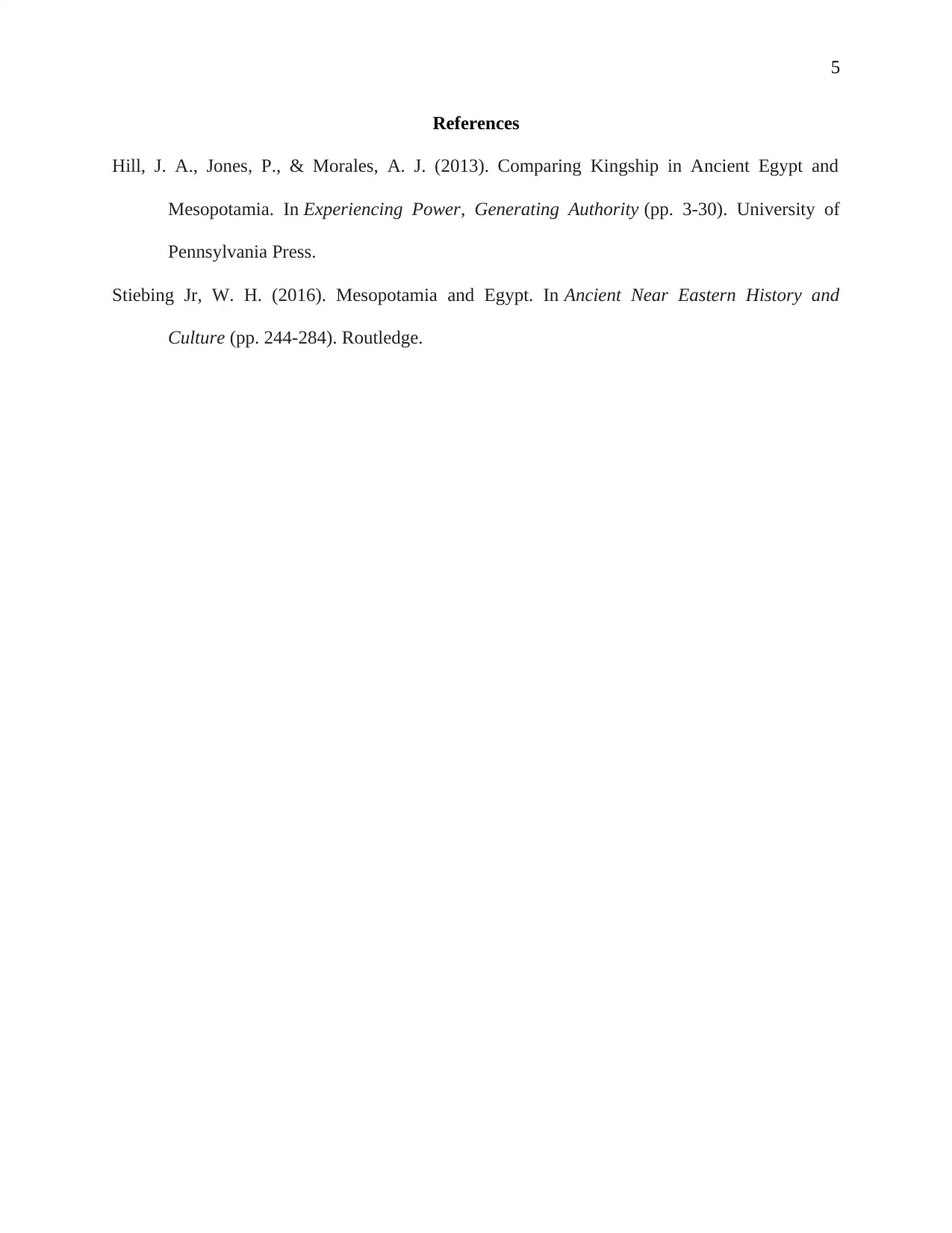
5
References
Hill, J. A., Jones, P., & Morales, A. J. (2013). Comparing Kingship in Ancient Egypt and
Mesopotamia. In Experiencing Power, Generating Authority (pp. 3-30). University of
Pennsylvania Press.
Stiebing Jr, W. H. (2016). Mesopotamia and Egypt. In Ancient Near Eastern History and
Culture (pp. 244-284). Routledge.
References
Hill, J. A., Jones, P., & Morales, A. J. (2013). Comparing Kingship in Ancient Egypt and
Mesopotamia. In Experiencing Power, Generating Authority (pp. 3-30). University of
Pennsylvania Press.
Stiebing Jr, W. H. (2016). Mesopotamia and Egypt. In Ancient Near Eastern History and
Culture (pp. 244-284). Routledge.
1 out of 5
Related Documents
Your All-in-One AI-Powered Toolkit for Academic Success.
+13062052269
info@desklib.com
Available 24*7 on WhatsApp / Email
![[object Object]](/_next/static/media/star-bottom.7253800d.svg)
Unlock your academic potential
© 2024 | Zucol Services PVT LTD | All rights reserved.





